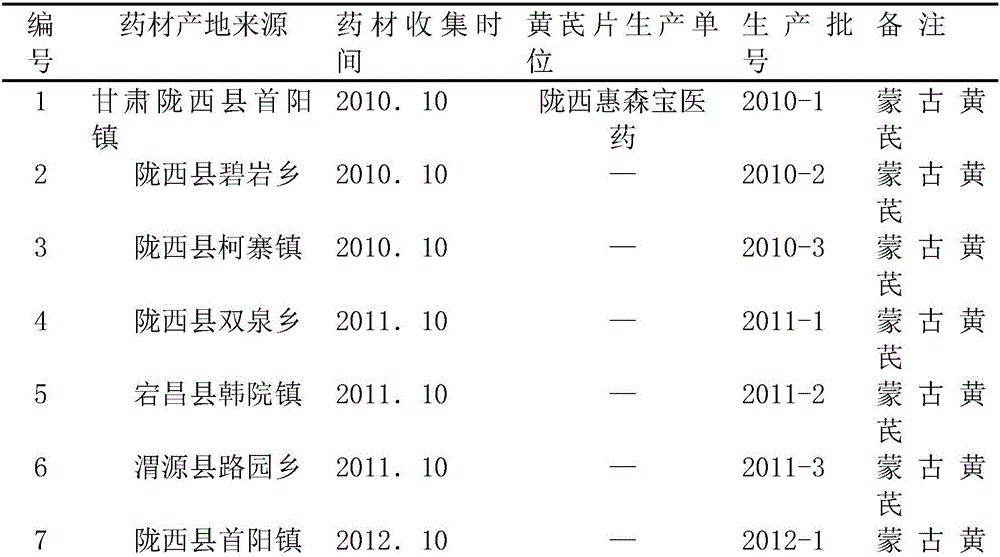A method for improving the identification of astragalus by thin layer chromatography
A technology of thin-layer chromatography and astragalus, applied in the field of improving the identification of astragalus by thin-layer chromatography, can solve the problems of high cost and low chromatographic clarity, and achieve the effect of simple method, obvious effect, and low resolution
- Summary
- Abstract
- Description
- Claims
- Application Information
AI Technical Summary
Problems solved by technology
Method used
Image
Examples
Embodiment 1
[0025] (1) First, grind 10 kinds of astragalus materials from different origins into powder, pass through a 200-mesh sieve, accurately weigh 2 g of the powder with a weighing balance, add 75 ml of chloroform-n-butanol with a volume ratio of 2:1, and heat Reflux, after 3h, filter, then evaporate the filtrate to dryness, add 8mL of KOH-methanol saponification solution with a mass fraction of 20% to the residue, place in a constant temperature water bath at 60°C for 30min; filter, and add 8mL of KOH-methanol saponification solution again , placed in a water bath at 100°C and heated to reflux for 1 hour, evaporated to dryness, added 30ml of water to dissolve the residue, and moved it to a separatory funnel; then added 2mL of methanol to fully dissolve the residue of Astragalus membranaceus, then extracted by ultrasonic for 30min, the ultrasonic power was 50W, and the ultrasonic temperature was 4°C , after extracting twice, add ethyl acetate to extract twice, each time 30mL, evapora...
Embodiment 2
[0028] (1) First, grind 10 kinds of astragalus materials from different origins into powder, pass through a 200-mesh sieve, accurately weigh 2 g of the powder with a weighing balance, add 75 ml of chloroform-n-butanol with a volume ratio of 2:1, and heat Reflux, after 3h, filter, then evaporate the filtrate to dryness, add 8mL of KOH-methanol saponification solution with a mass fraction of 20% to the residue, place in a constant temperature water bath at 60°C for 30min; filter, and add 8mL of KOH-methanol saponification solution again , placed in a water bath at 100°C and heated to reflux for 1 hour, evaporated to dryness, added 30ml of water to dissolve the residue, and moved it to a separatory funnel; then added 2mL of methanol to fully dissolve the residue of Astragalus membranaceus, then extracted by ultrasonic for 30min, the ultrasonic power was 50W, and the ultrasonic temperature was 4°C , after extracting twice, add ethyl acetate to extract twice, each time 30mL, evapora...
Embodiment 3
[0031] (1) First, grind 10 kinds of astragalus materials from different origins into powder, pass through a 200-mesh sieve, accurately weigh 3g of the powder with a weighing balance, add 75ml of chloroform-n-butanol with a volume ratio of 2:1, and heat Reflux, after 3h, filter, then evaporate the filtrate to dryness, add 10mL of KOH-methanol saponification solution with a mass fraction of 20% to the residue, place in a constant temperature water bath at 60°C for 30min; filter, and add 10mL of KOH-methanol saponification solution again , placed in a water bath at 100°C and heated to reflux for 1 hour, evaporated to dryness, added 30ml of water to dissolve the residue, and moved it to a separatory funnel; then added 2mL of methanol to fully dissolve the residue of Astragalus membranaceus, then extracted by ultrasonic for 30min, the ultrasonic power was 50W, and the ultrasonic temperature was 4°C , after extracting twice, add ethyl acetate to extract twice, each time 30mL, evapora...
PUM
 Login to View More
Login to View More Abstract
Description
Claims
Application Information
 Login to View More
Login to View More - R&D
- Intellectual Property
- Life Sciences
- Materials
- Tech Scout
- Unparalleled Data Quality
- Higher Quality Content
- 60% Fewer Hallucinations
Browse by: Latest US Patents, China's latest patents, Technical Efficacy Thesaurus, Application Domain, Technology Topic, Popular Technical Reports.
© 2025 PatSnap. All rights reserved.Legal|Privacy policy|Modern Slavery Act Transparency Statement|Sitemap|About US| Contact US: help@patsnap.com



